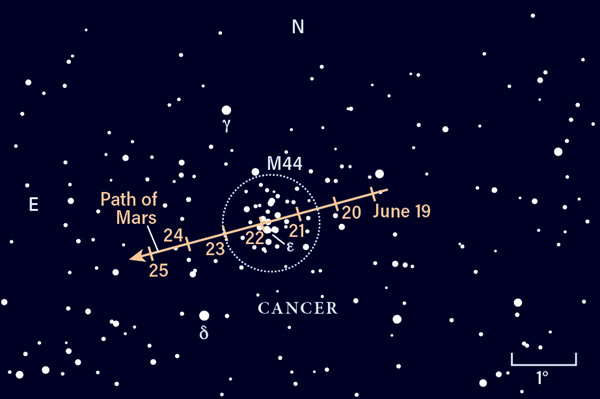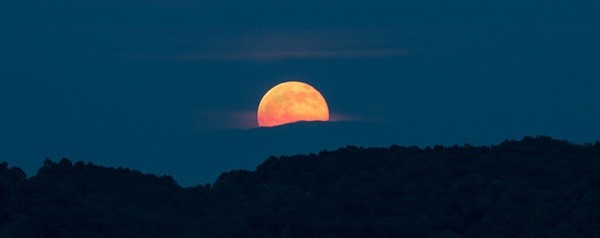The Sky This Week: Welcome, summer!

Summer evening: The summer solstice occurs June 20, bringing the longest day of the year and kicking off the summer season in the Northern Hemisphere.
Friday, June 18
An hour after sunset, the bright red star Antares, located in Scorprius, is visible above the southern horizon. This magnitude 1 star is located in a rich region of the sky rife with star clusters, including M4, a globular cluster less than 1.5° due west of Antares. M4 is an easy magnitude 5.6 and spans about 36'. At just 7,200 light-years from Earth, it’s one of the nearest globular clusters to our planet. Many observers can see a straight “bar” structure of 11th-magnitude stars within the cluster’s core.
Wait a little longer, and two open clusters — M6 and M7 — will appear as Scorpius’ tail clears the horizon. These are much younger, looser groupings of stars than M4, and excellent binocular targets for even beginning observers to enjoy. M6 is located about 5° north-northeast of magnitude 1.6 Shaula; M7 is 2.4° north-northeast of 3rd-magnitude G Scorpii.
Saturday, June 19
Last night, the waxing Moon stood near Spica’s magnitude 2.7 star Porrima. Tonight, the Moon remains in the Maiden, now just over 5° above (northeast of) the constellation’s magnitude 1 alpha star, Spica.
Spica is easy to find by following the Big Dipper’s handle as it “arcs to Arcturus” in Boötes, then simply “spike to Spica,” which lies nearly 33° south-southwest of Arcturus. Because Spica lies close to the ecliptic, or plane of the solar system, the Moon frequently passes nearby or even in front of the star, occulting it. Given its bright magnitude and its relatively small distance of 250 light-years, Spica is an intrinsically brilliant star some 1,900 times brighter than the Sun. But Spica is a bit deceiving — it’s not one but two hot, bright B-type stars separated by about one-tenth the average Earth-Sun distance and circling each other every four days.
Sunday, June 20
The summer solstice occurs at 11:32 P.M. EDT, marking the beginning of Northern Hemisphere summer. According to NASA, June 20 is also the day with the most sunlight this year: 14 hours 53 minutes 41.6 seconds.
You can ring in summer by enjoying one of the summer sky’s finest sights: the Great Globular Cluster in Hercules. Officially cataloged as M13, this ancient grouping of stars reigns high in the summertime night sky among the stars of the Son of Zeus. Discovered by Edmond Halley — who also discovered that famous comet — in 1714, M13 spans 20' and contains several hundred thousand stars with a combined magnitude of 5.8. It’s a treat through any binoculars or telescope, and is even a naked-eye object under the right conditions (it will appear as a dim bit of “fuzz”). You can find it about one-third of the way from Eta (η) Herculis to Zeta (ζ) Herculis, roughly 2.5° south of the former.
Monday, June 21

Mars meanders through the Manger: Mars passes through the Beehive Cluster (M44) — also known as Praesepe or the Manger — late this month.
Jupiter’s eastward progression grinds to a halt as the giant planet stands stationary at 1 A.M. EDT in the constellation Aquarius. After today, it will begin moving retrograde, or westward, against the background stars. You can find the planet early this morning in the southeastern sky, blazing at magnitude –2.6. Saturn sits in Capricornus, 19.3° to Jupiter’s west and glowing a more muted magnitude 0.3. Both are outstanding telescopic targets: Jupiter spans 44" and is flanked by its four Galilean moons, while Saturn’s disk stretches 18" and its rings cover a width of about 41". The ringed planet is surrounded by an array of moons, including magnitude 8.6 Titan, nearly 3' to Saturn’s east. The large moon will sit due south of the planet is just a few days, on the 24th.
If evening observing is more your speed, you won’t be disappointed. Tonight through the 23rd, Mars is crossing the Beehive Cluster (M44) in Cancer. Step outside about an hour after sunset to find the Red Planet roughly 13° high and shining at magnitude 1.8 amid a fuzzy smattering of blue stars. Binoculars or a telescope will net you the best view, but you’ll need to be quick, as Mars sets by 11 P.M. local time. The clearer your view of the western horizon, the longer you’ll be able to follow it down.
Mars will sit smack dab in the middle of the cluster tomorrow evening, and at the opposite edge of the grouping by the night of the 23rd.
Tuesday, June 22
Venus passes 5° south of Pollux in Gemini at 11 A.M. EDT. By sunset, they’re about 5.5° apart. About half an hour later, both should be visible: Venus is magnitude –3.9 and will appear before the magnitude 1.2 star pops out against the deepening twilight. As darkness continues to fall, magnitude 1.6 Castor will appear to the right of Pollux as Gemini sinks feet-first below the horizon. Within two days’ time, Venus will appear directly in line with these two stars, then standing 6.5° from Pollux.
Mercury is stationary tonight at 7 P.M. EDT in Taurus the Bull. It’s currently a morning object, rising as the sky brightens in anticipation of sunrise. If you want to see the solar system’s smallest, speediest planet, it rises around 4:40 A.M. local time and hangs amid only a few other bright stars in the sky as it climbs above the horizon, including Aldebaran and Capella. Through a telescope, it’s a mere 16-percent-lit crescent that spans 10" in apparent diameter on the sky.
Wednesday, June 23
The Moon reaches perigee, the closest point to Earth in its orbit, at 5:55 A.M. EDT. At that time, our natural satellite will sit 223,666 miles (359,956 kilometers) away.
The Moon also sets around 4:15 A.M. local time, giving you a narrow window of dark sky in which to find our solar system’s most distant planet, Neptune. Located in northeastern Aquarius, the magnitude 7.8 planet is visible in binoculars or a small telescope. It sits 21° northeast of Jupiter and 5.7° northeast of magnitude 4.2 Phi (ϕ) Aquarii. Once you’ve zoomed in on its location, you’ll see the planet sits just 7' from a magnitude 7.2 field star, making the pair appear almost like a double star. Of the two, Neptune is a bit fainter and “flatter,” its 2"-wide disk distinctly different from the more pointlike star.

Strawberry Moon: A Full Moon rises over West Virginia on the summer solstice in 2016. June’s Full Moon is called the Strawberry Moon.
Thursday, June 24
Full Moon occurs at 2:40 P.M. EDT today. The June Full Moon is also popularly known as a Strawberry Moon and can best be seen rising in the southeast about half an hour after sunset. Tonight, the Moon floats near the lid of Sagittarius’ Teapot asterism, which may be a bit difficult to make out with the bright moonlight in the region. The Moon sits a mere 48' from Phi Sagittarii, which marks the left-hand corner of the Teapot’s body and lid, as well as the top of the handle where it attaches to the pot.
Because the Moon will be the biggest, brightest object in the sky, take some time to admire our natural satellite. Lunar observing is easy and fun for all, whether you have binoculars, a telescope, or choose to simply use your eyes. Even the naked eye can discern the large dark patches across the Moon’s face, known as maria or seas, which are actually ancient lava flows that have smoothed out portions of the surface. Rugged rings of mountains and the spreading rays of craters are also visible to all; the higher your magnification, the more detail you’ll get in your view. Observing at high magnification can also make viewing the Full Moon a bit easier, as it cuts down on the amount of light reflected off the surface — and into your eyes.
Friday, June 25
With a bright Moon still in Sagittarius, it’s best to focus on easy targets on the other side of the sky today. Early in the morning a few hours before sunrise, the Great Square of Pegasus — formed by the stars Alpheratz, Algenib, Markab, and Scheat — is high in the east. Magnitude 2.4 Enif, in the constellation’s southwestern region, marks the Winged Horse’s nose. At 670 light-years away, this yellow giant star’s total luminosity is 6,700 times greater than our Sun’s. The star itself is also 185 times larger than the Sun.
Home in on Enif with binoculars or a small scope, and you’ll see a fainter “companion” about 2' northwest of the star. This is a chance alignment — these two stars are not associated in real space, but make a nice visual double. Next, slide your gaze 4° northwest of bright Enif and you’ll run right into the bright globular cluster M15. This densely packed grouping of around 100,000 stars sits 33,600 light-years away and glows at magnitude 6.2, spanning about 18' on the sky. It is home to numerous variable stars — at least 112 have been identified within it so far.
Source: Astronomy Magazine